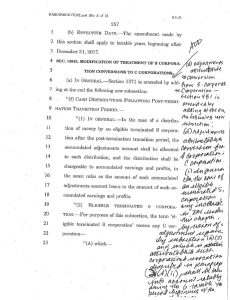I recently published a blog post with two colleagues, Gigi Jones and Abby Miller, taking a look at merit aid awarded by institutions to students. We used the recently-released NPSAS:2020 data to look at the trends in who received merit aid.
Uncategorized
Tax reform that harms graduate students and university employees
The competing House and Senate tax reform bills are large, complex, and often difficult to understand. The Senate bill, for example, is a 479-page document that was passed early in the morning last Saturday and that included last-minute, hand-written passages as shown to the right.  There are numerous parts of each bill that have a large impact on colleges and universities in the country, as well as their students. One estimate calculated after the House bill was passed is that if enacted into law, it would cost students and their families $71 billion over the next ten years. Now that both chambers have passed bills, a conference committee will try to hash out the differences and agree on one bill to be passed by both the House and Senate and sent on to President Trump to be signed into law. Continue reading “Tax reform that harms graduate students and university employees”
There are numerous parts of each bill that have a large impact on colleges and universities in the country, as well as their students. One estimate calculated after the House bill was passed is that if enacted into law, it would cost students and their families $71 billion over the next ten years. Now that both chambers have passed bills, a conference committee will try to hash out the differences and agree on one bill to be passed by both the House and Senate and sent on to President Trump to be signed into law. Continue reading “Tax reform that harms graduate students and university employees”
On reading, or the legacy of Donald E. Westlake (part 2)
Part 1 of this post.
I did not read another Donald E. Westlake novel after I graduated from high school and left Madison, even though he published many more volumes before he died in 2008. I discovered other writers and topics that garnered my attention, both through my studies in college and graduate school as well as outside of those topics. But I have maintained my love of reading throughout the subsequent years.
When I finished my doctoral studies and had a few months free between graduation and when I started my first job as an assistant professor, I bought myself the present of a copy of the John Updike book, Rabbit Angstrom: A Tetralogy. The volume, published a couple of years earlier, was a compilation of Updike’s four Rabbit novels, each of which I had read in sequence over a period of about 20 years earlier in my life. For me, it was an indulgence to be able to sit and reread all four of these books, which were among my favorites of all time (ranking right up there with Westlake, of course), and which chronicled the life of Harry “Rabbit” Angstrom from high school through the end of his life.
Continue reading “On reading, or the legacy of Donald E. Westlake (part 2)”
On reading, or the legacy of Donald E. Westlake (part 1)
I was on vacation back east last week, not far from the small town in Connecticut in which I grew up. I lived there from birth until I graduated from high school and went off to college. Madison was small, at least by the standards of the eight other places I have lived since then, all of which dwarf Madison in size. The population when I left in 1977 was somewhere in the ballpark of 10,000 people; the most recent census data show that the town has grown somewhat since then, but as of last year the population was still only about 18,000.
There were not a lot of diversions for an adolescent the town back then. There was no arcade; in fact, I don’t think there was even any public place that had a pinball machine. There was no fast food; the closest was the soda counter at Jolly’s, one of two drug stores in the town. Television was limited to over-the-air channels, which consisted of the three major networks, ABC, NBC, and CBS; public broadcasting; and three independent stations from New York City – WOR, WNEW, and WPIX – which I recall broadcast mostly reruns and professional sports.
Continue reading “On reading, or the legacy of Donald E. Westlake (part 1)”
A massive fail on ROI calculations for community colleges
Last spring, I posted about the challenge of calculating a return on investment (ROI) for individual colleges. The problem is with obtaining accurate data on the earnings of the graduates of a given college or university. I described there the problem with a ROI website created by the firm PayScale, which relies on self-reported data from individuals. There are a number of issues with PayScale’s methodology, but the biggest is that there is just no way to know how representative the respondents to their surveys are of the totality of the graduates for any single institution. There is also no way to judge the accuracy of the data reported.
Now there is another report out that uses the PayScale data to calculate ROI measures for community colleges. Last week, a study issued jointly by theNexus Research and Policy Center and the American Institutes for Research (AIR) took on the challenge of calculating the returns to associate’s degrees not just for individuals, but also for taxpayers in the form of the government subsidy provided to community colleges. There are a number of methodological problems with this study, which examined 579 community colleges around the country, but key among them is the study’s reliance on the PayScale data as the outcome measure for the ROI calculations. AIR is also the author of the College Measures website which, as I described in last spring’s post, shares the same flaw in using the PayScale data for some of its analyses.
Continue reading “A massive fail on ROI calculations for community colleges”
The unintended consequences of linking earnings and college performance

In one of my posts on President Obama’s college costs proposals, I described how the president is proposing to link eligibility for federal financial aid to the earnings of the graduates of colleges and universities. The general idea is that only those colleges that produce graduates who earn reasonable salaries should benefit from federal financial aid.
Last week I attended the dedication of the new Theatre School building at DePaul University (shown above), where I am a trustee. The building, designed by renowned architect Cesar Pelli, is a beautiful and functional space. The dedication was a wonderful event that included short performances by students in the acting programs at the Theatre School.
Continue reading “The unintended consequences of linking earnings and college performance”
Measuring the return on investment of attending college (Part 2)
In my last post, I described the challenges in obtaining accurate and comprehensive data on the salaries earned by graduates of individual colleges around the nation. While there is much interest in using data on the earnings of college graduates as a means for ranking colleges, there is no single source of data on all colleges in the country (or even a majority of them) that allows us to compare institutions in this manner. Even if we did have accurate data, is the salary of recent graduates the primary criterion we should use in judging higher education institutions?
Continue reading “Measuring the return on investment of attending college (Part 2)”
Making sausage in the Department of Education
Having taught educational policy throughout most of my career as a faculty member, I would often start the course with the old saying, “Policy is like sausage – you don’t want to see either being made.” Just as most of us would not like to watch the sausage making process, for fear that we would find out what gets ground up and put into it, many of us – even those who consider ourselves “policy wonks” – similarly wish we could close our eyes as we watch the policy making process. As I write, there is a good example of sausage-making going on at the Department of Education in Washington.
The Department, and Secretary of Education Arne Duncan as its leader, has been pushing for more rigorous assessment of teachers and the programs that train them. This is a goal that is understandable and laudable; there has been much attention paid lately to the issue of teacher quality and how school districts can determine which are the most effective teachers and which are the least. Mary Kennedy, a faculty member in our Teacher Education program, edited a recent book on the topic – Teacher Assessment and the Quest for Teacher Quality: A Handbook. You can also read a briefing on the topic written by our Teacher Education program a few years ago.
Continue reading “Making sausage in the Department of Education”